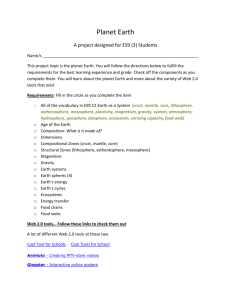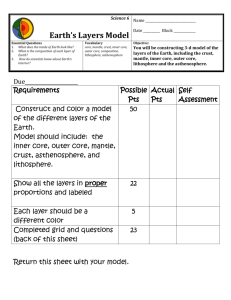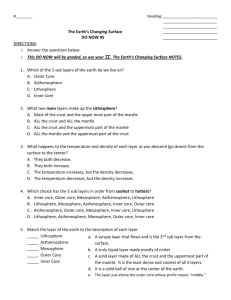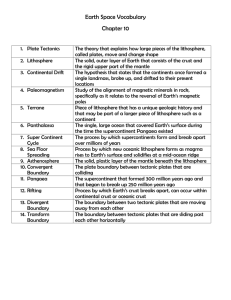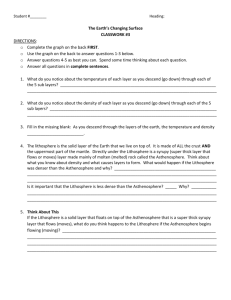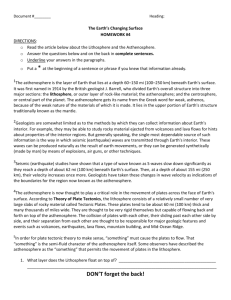File
advertisement
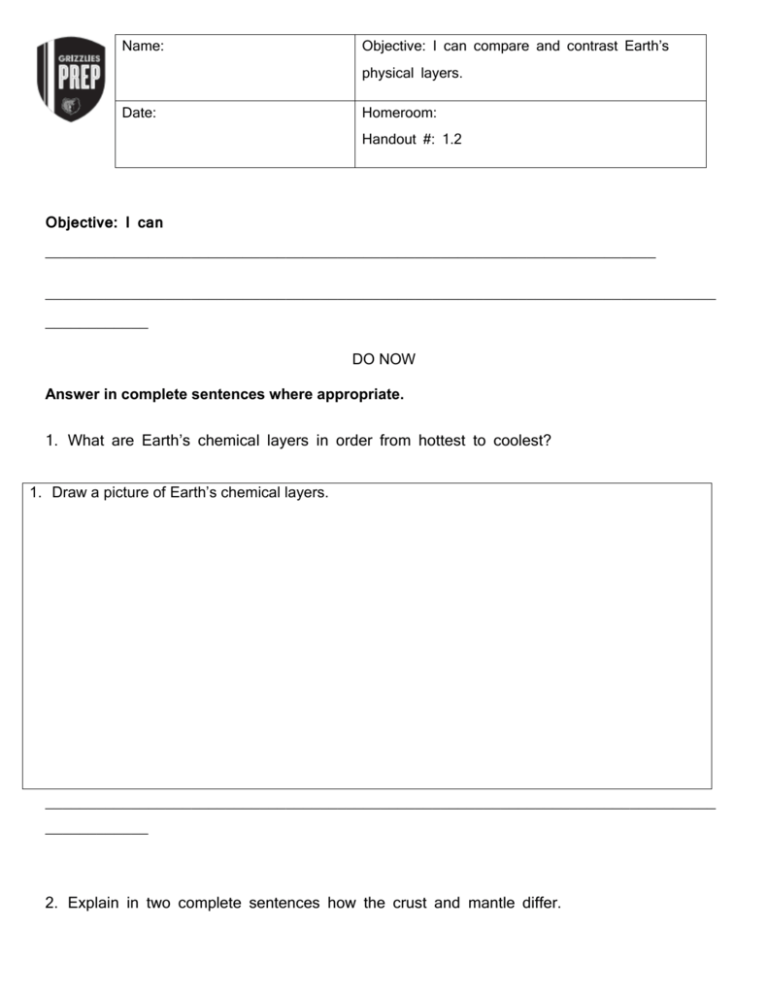
Name: Objective: I can compare and contrast Earth’s physical layers. Date: Homeroom: Handout #: 1.2 Objective: I can _______________________________________________________________________ ______________________________________________________________________________ ____________ DO NOW Answer in complete sentences where appropriate. 1. What are Earth’s chemical layers in order from hottest to coolest? 1. Draw a picture of Earth’s chemical layers. ______________________________________________________________________________ ____________ 2. Explain in two complete sentences how the crust and mantle differ. ______________________________________________________________________________ ____________ ______________________________________________________________________________ ____________ ______________________________________________________________________________ ____________ ______________________________________________________________________________ ____________ Objective: I can compare and contrast the lithosphere, asthenosphere, and mesosphere. The Physical Structure of the Earth Another way to look at the Earth is to examine the physical properties of its layers. The Earth is divided into five physical layers—the lithosphere, asthenosphere, mesosphere, inner core, and outer core. As shown below, each layer has its own set of physical properties. 2 1. What is the difference between categorizing Earth’s layers by chemical composition and physical properties? ______________________________________________________________________________ ____________ ______________________________________________________________________________ ____________ 2. What are the five physical layers of Earth? ______________________________________________________________________________ ____________ ______________________________________________________________________________ ____________ 3 Lithosphere Tectonic Plates Pieces of the lithosphere that move around on top of the plasticlike asthenosphere are Shoulder partners: Look at the picture below. How does the size of the plates compare to the size of continents? Also, what do tectonic plates remind you of? What else do you notice about the plates? called tectonic plates. But what exactly does a tectonic plate look like? How big are tectonic plates? How and why do they move around? 4 3. Name an example of a plate that has only oceanic crust. ______________________________ 4. Name an example of a plate that has oceanic and continental crust. ____________________ Composition of Earth’s Plates Tectonic plates are made of the crust and upper mantle. These two parts combined are the lithosphere. This rigid layer is about 100 km thick and generally is less dense than material underneath. The plasticlike layer below the lithosphere is called the asthenosphere. The rigid plates of the lithosphere float and move around on the asthenosphere. The figure below shows what the South American plate might look like if it could be lifted out of its place. Notice that is consists of both oceanic and continental crust. The thickest part is the continental crust. The thinnest part is in the mid-Atlantic ocean. 5 5. What are tectonic plates? _____________________________________________________________ ______________________________________________________________________________ ____________ 6. What does the lithosphere include? ____________________________________________________ ______________________________________________________________________________ ____________ 7. What physical layer lies just beneath the lithosphere? ______________________________________________________________________________ ____________ The Mesosphere The mesosphere is the part of the mantle that lies beneath the lithosphere and asthenosphere, but above the outer core. The upper boundary is defined as the sharp increase in seismic wave velocities and density at a depth of 660 km. As depth increases, pressure builds and forces material into a denser, more rigid1 structure. Therefore, the difference between mesosphere and asthenosphere is likely due to density and rigidity differences, that is, physical factors, and not to any difference in chemical composition. The base of the lower mantle is at about 2700 km. 8. What does it mean that the asthenosphere and mesosphere are physically different but not chemically different? ______________________________________________________________________________ ____________ 1 Rigid means not easily moved. 6 ______________________________________________________________________________ ____________ ______________________________________________________________________________ ____________ 9. Does density increase or decrease in Earth’s layers as pressure increases? Why? ______________________________________________________________________________ ____________ ______________________________________________________________________________ ____________ ______________________________________________________________________________ ____________ Instructions: Fill in the table below with important information about each of Earth’s physical layers. Lithosphere Asthenosphere Mesosphere 7
